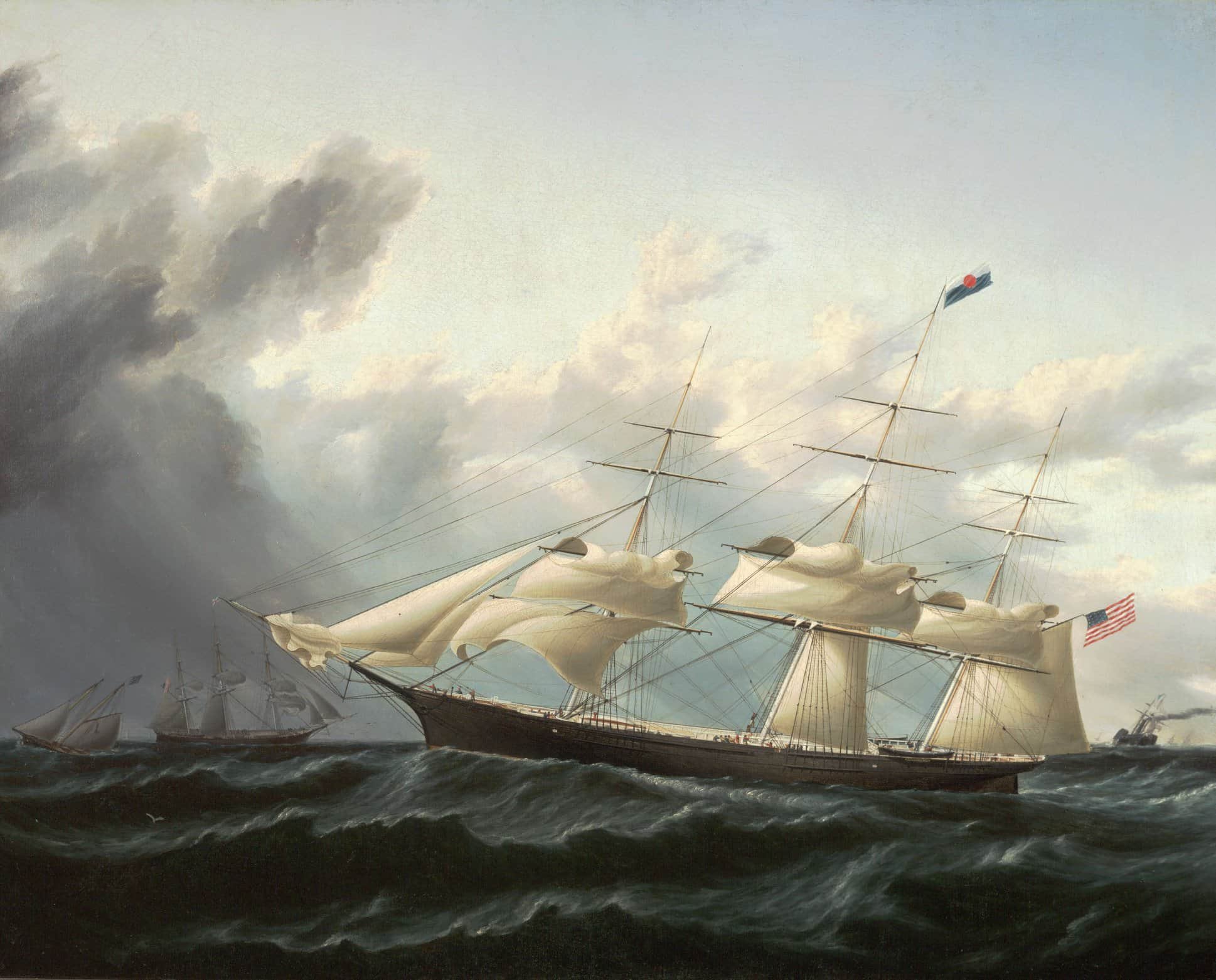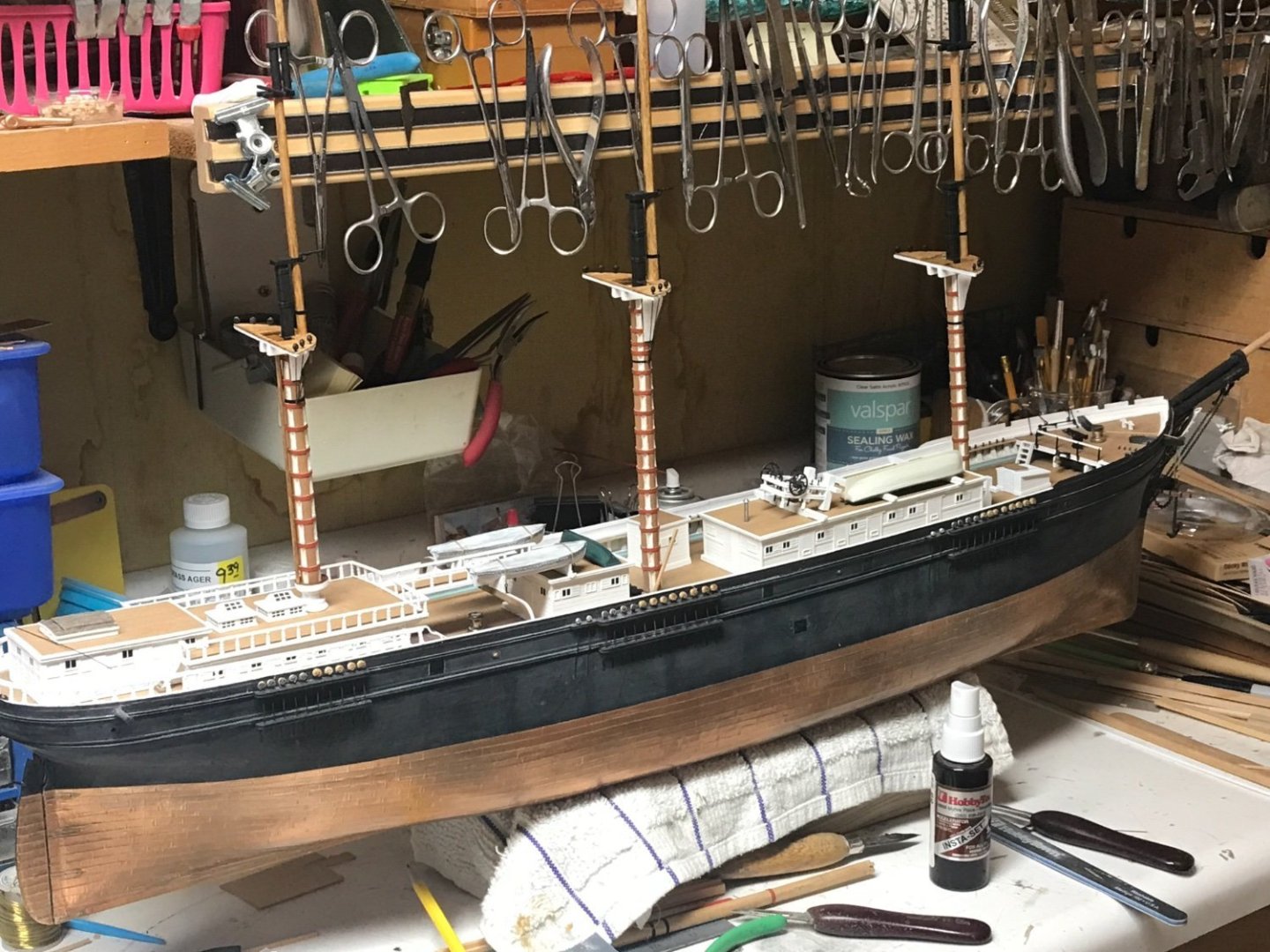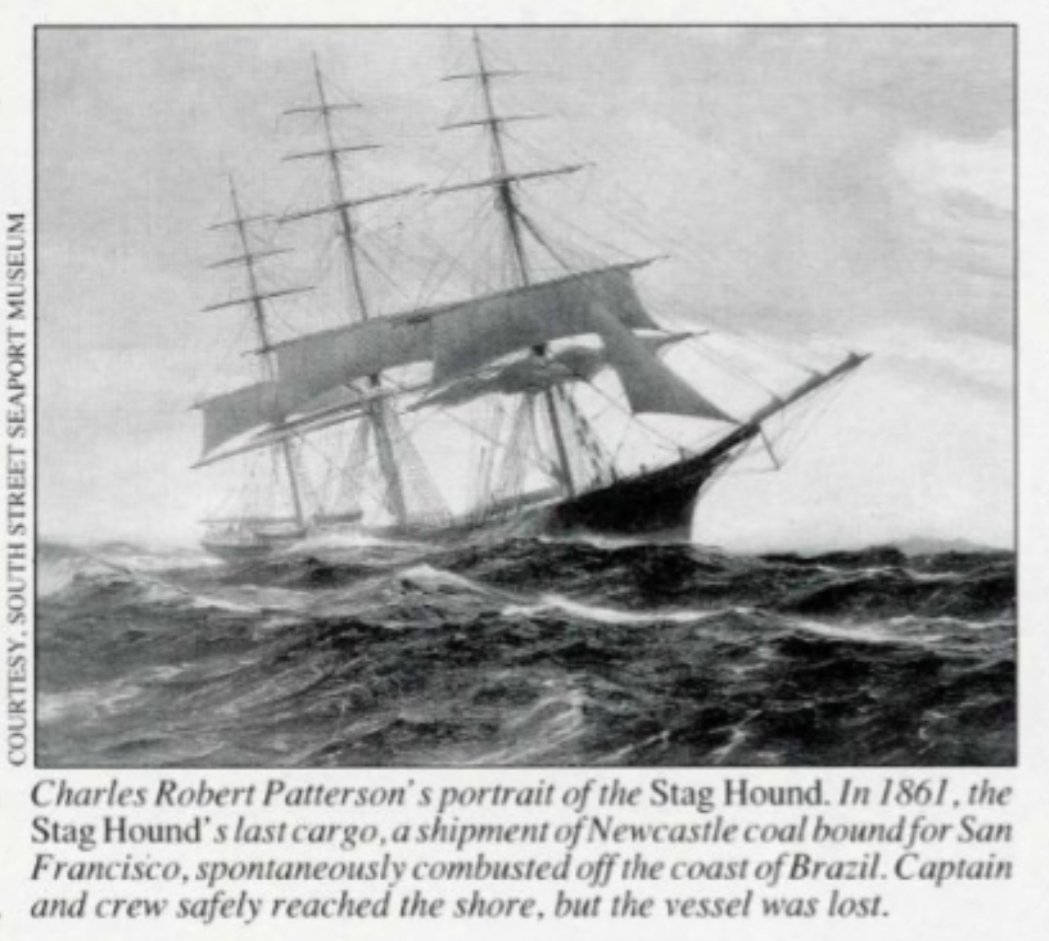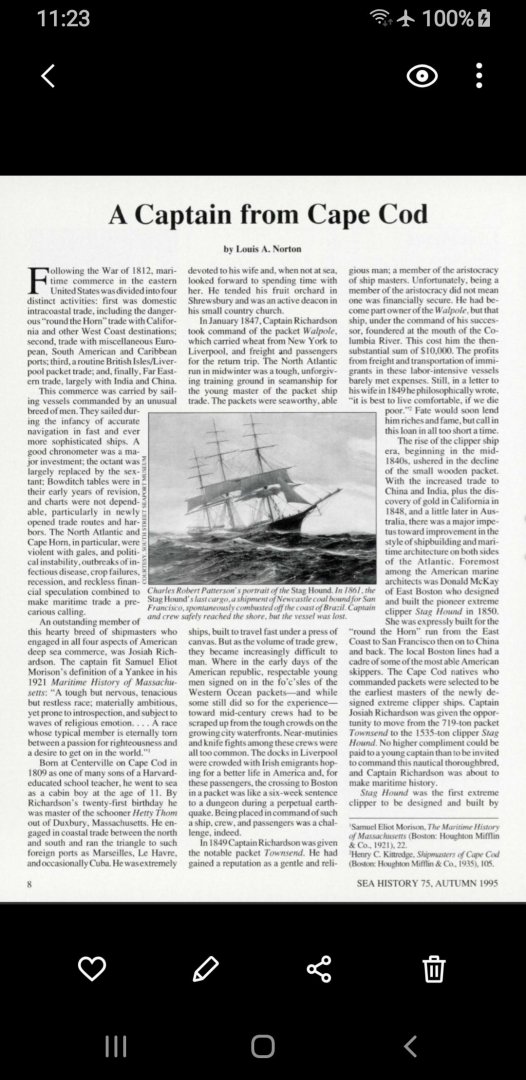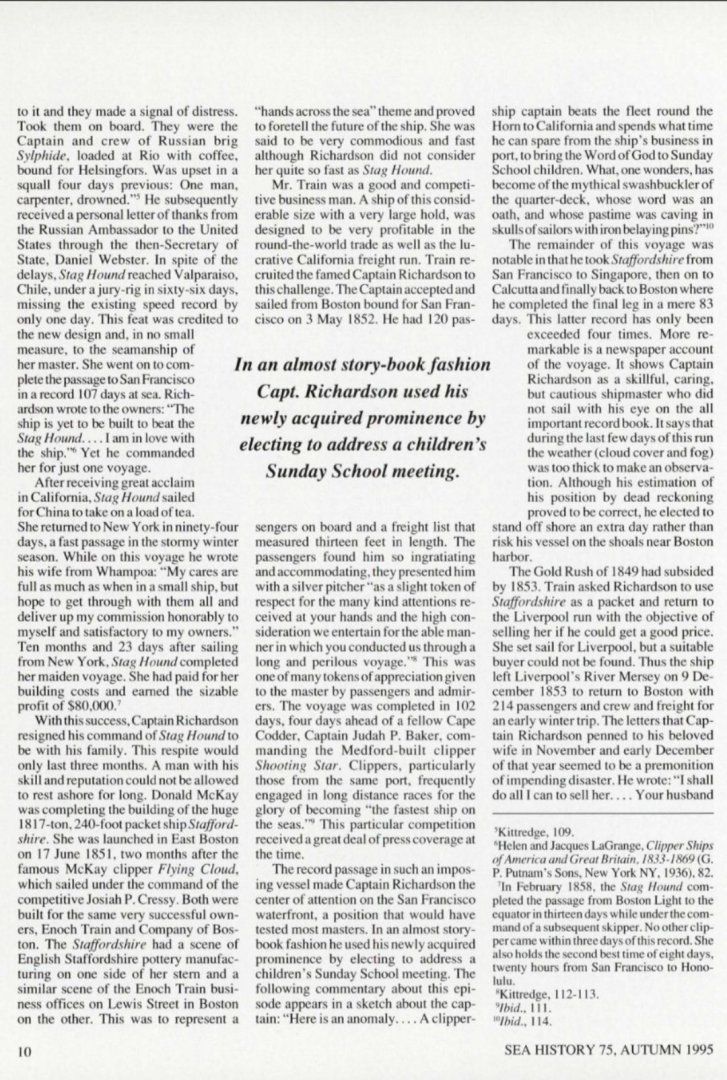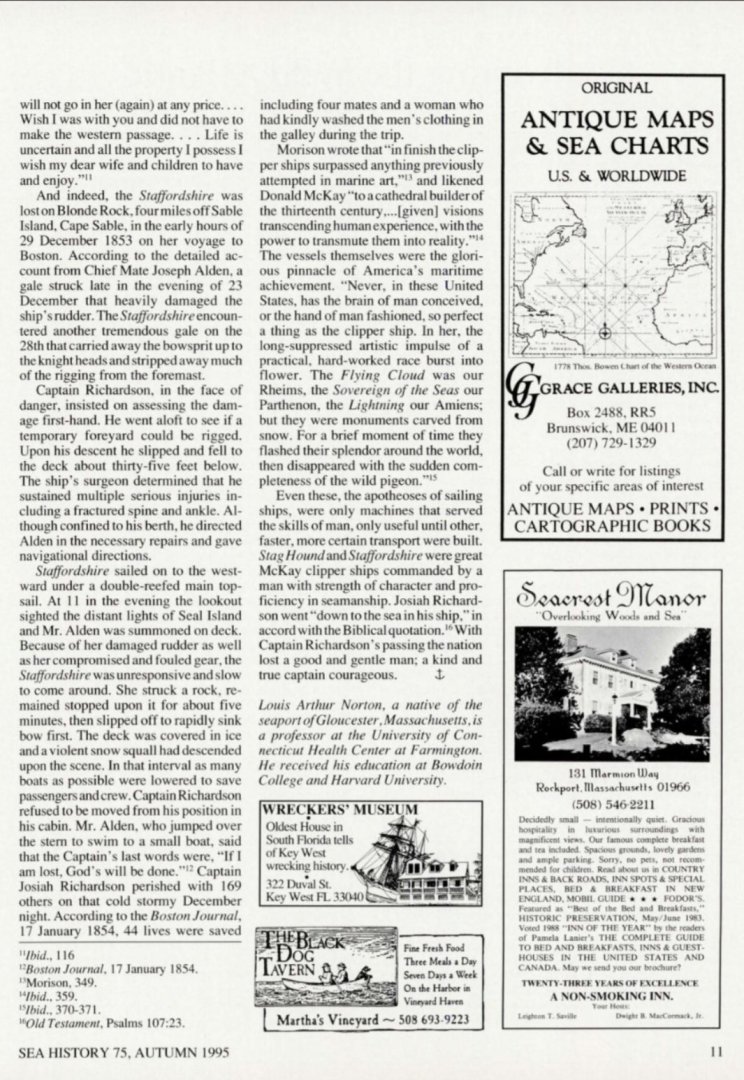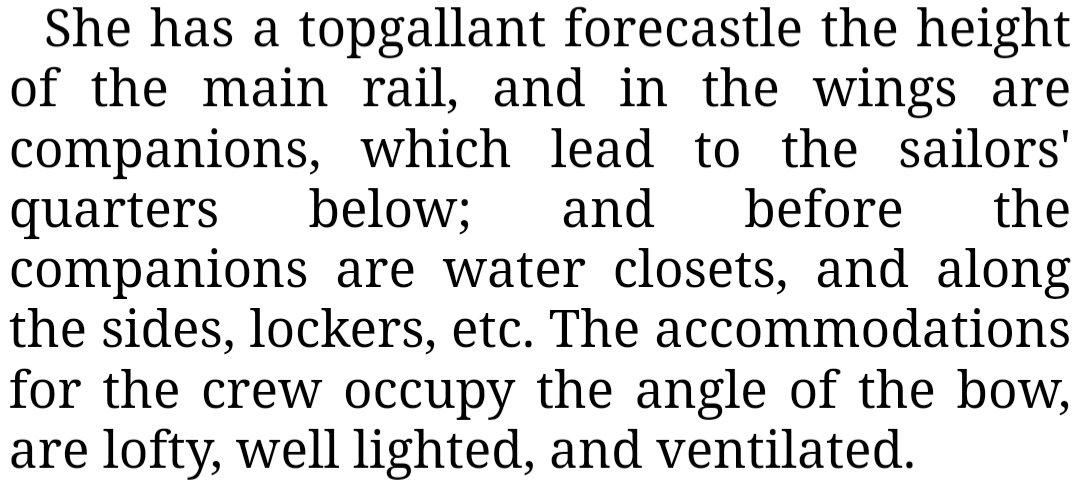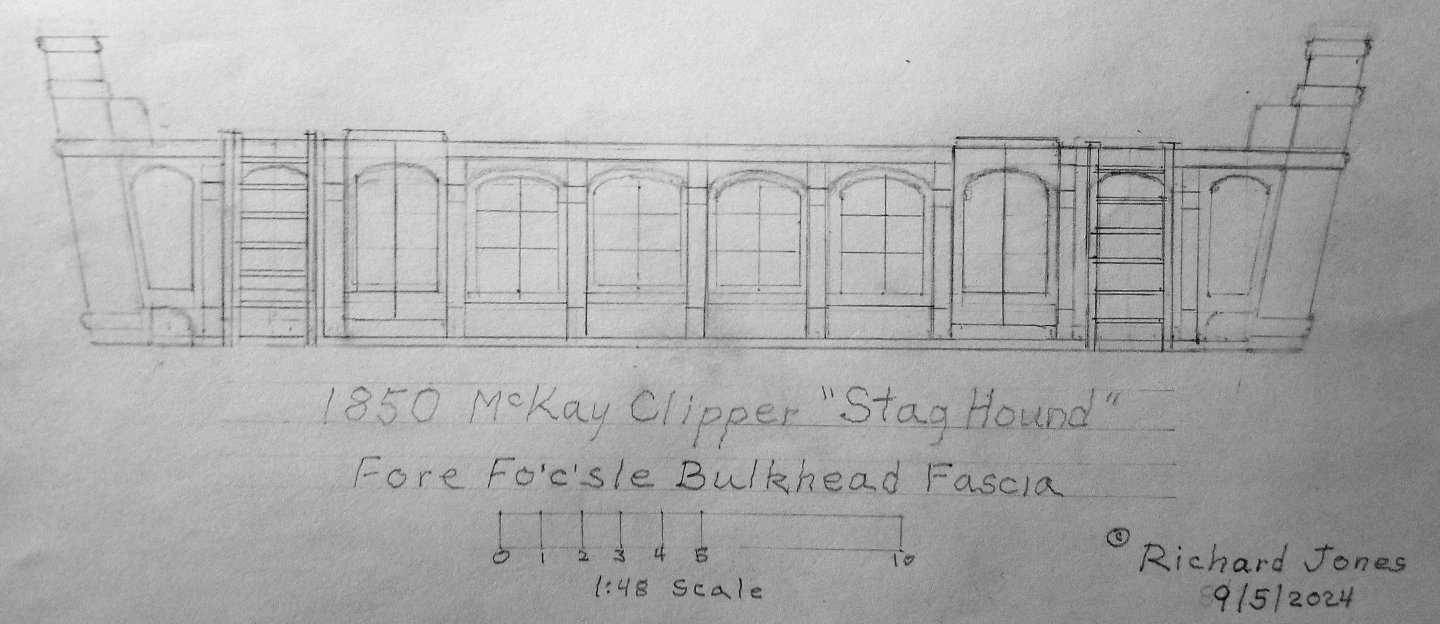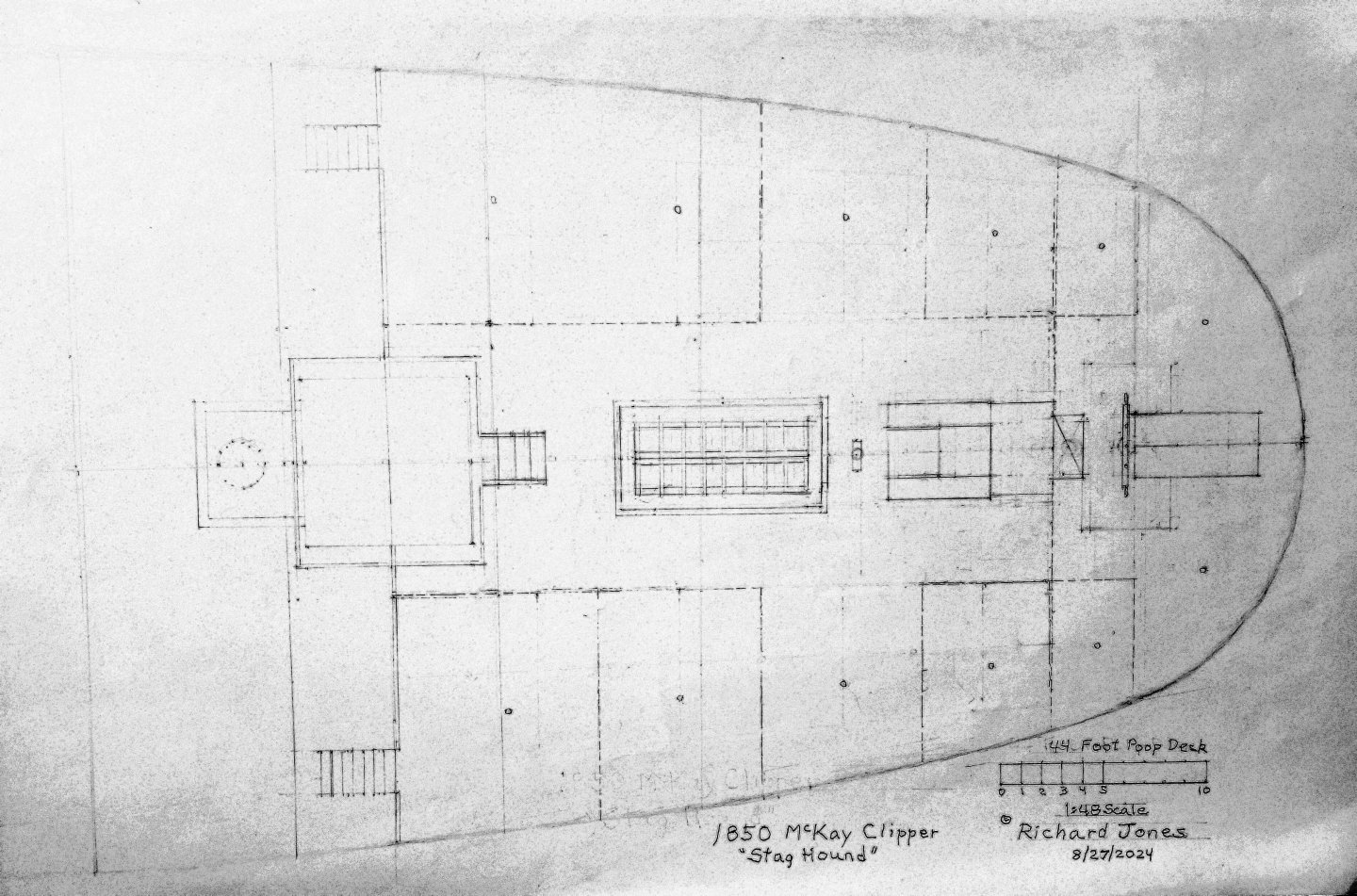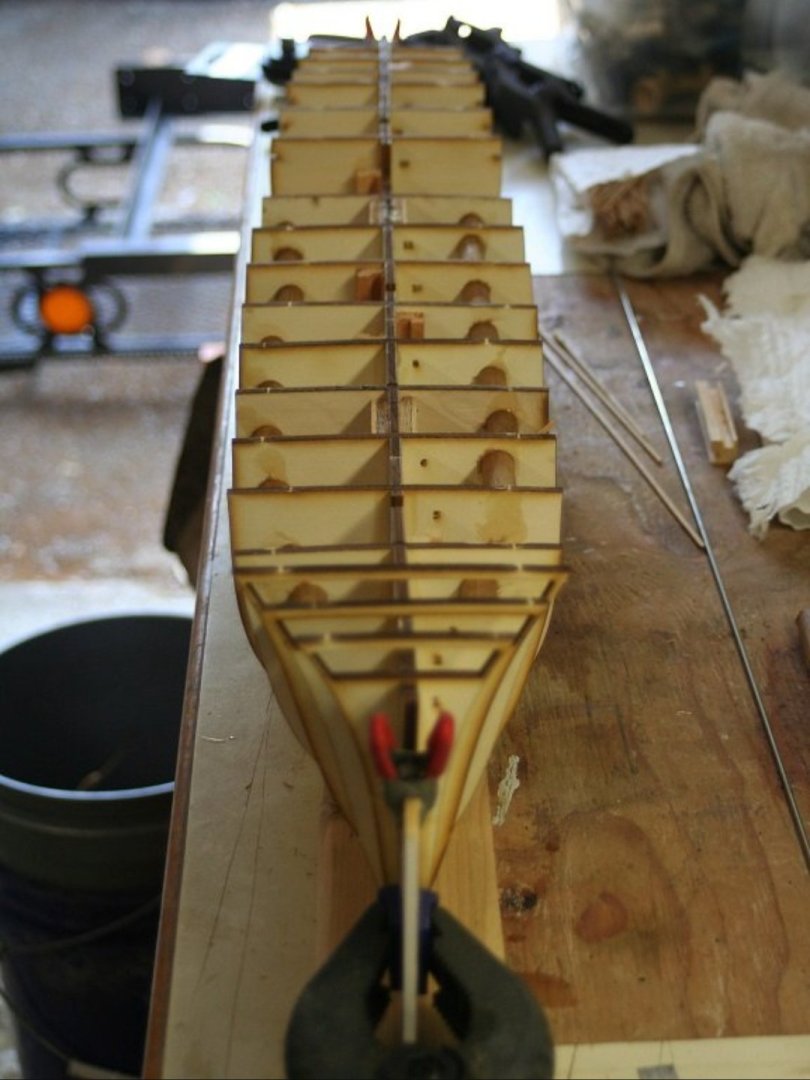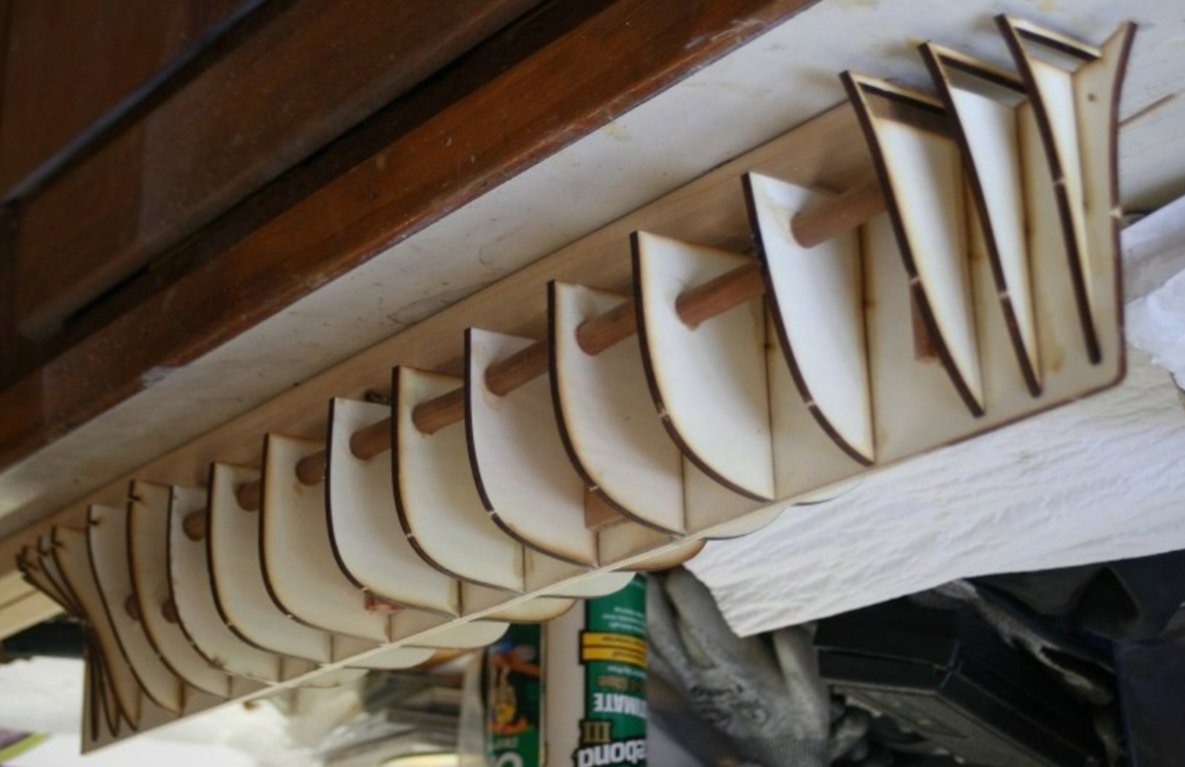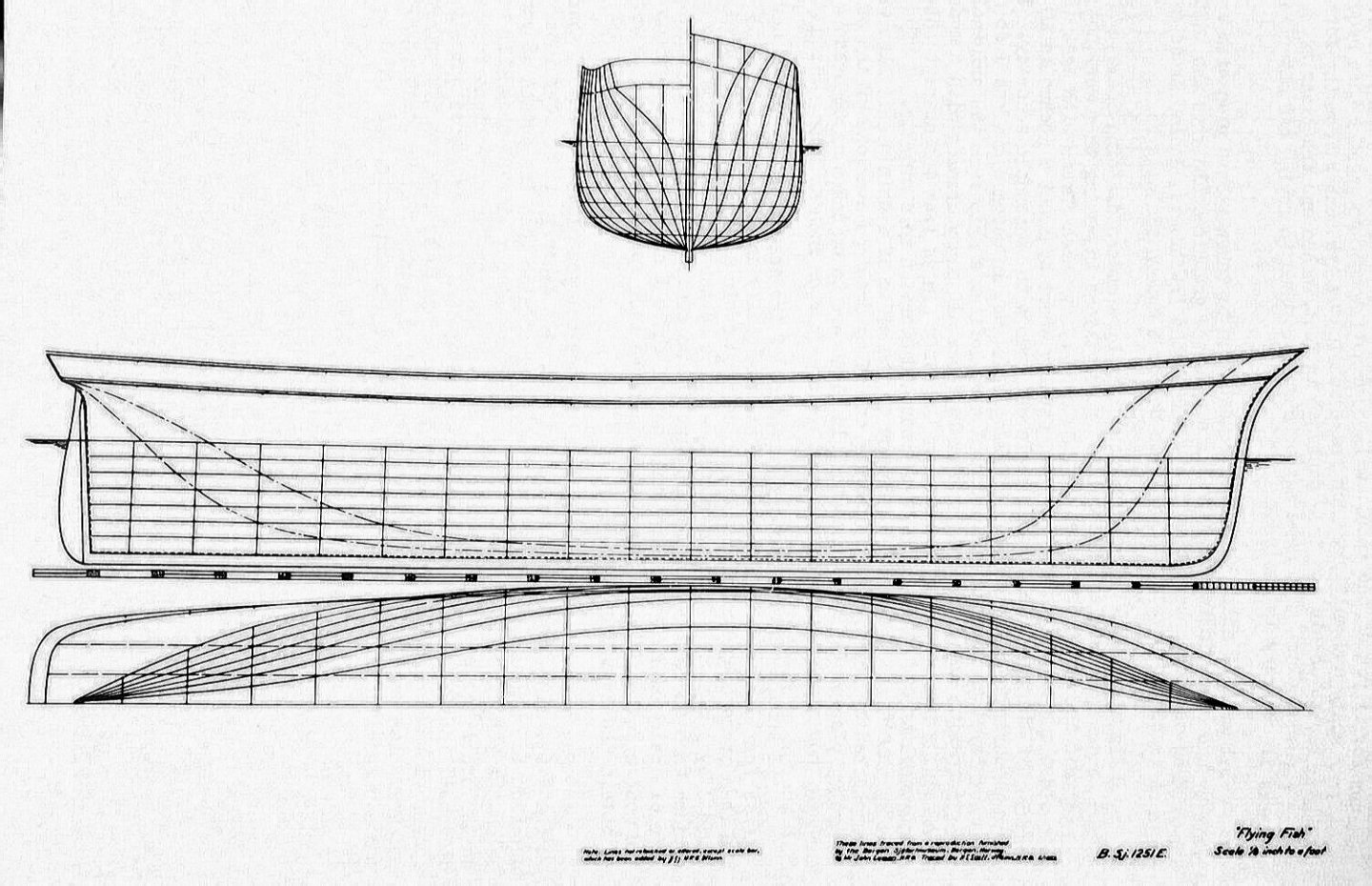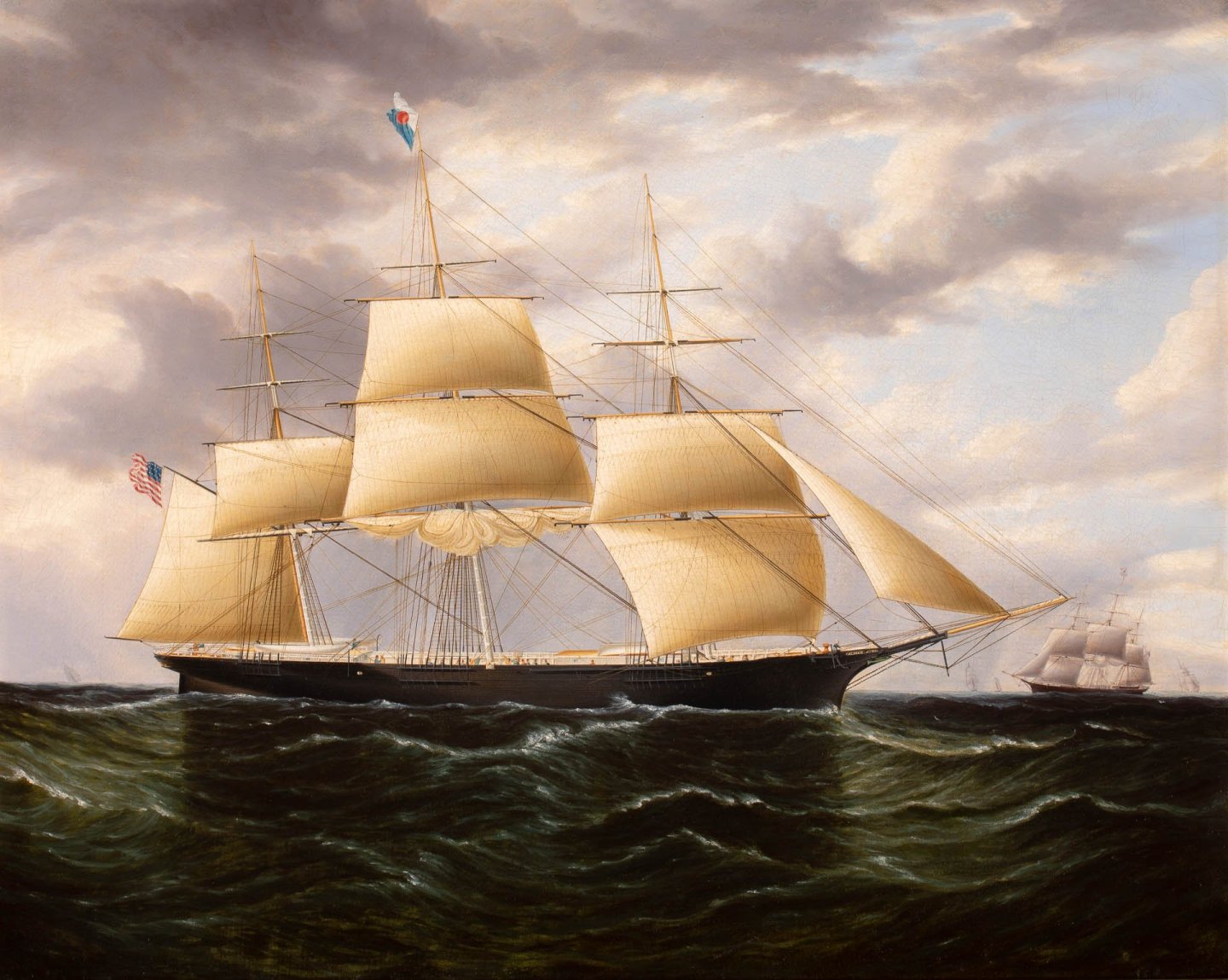-
Posts
2,168 -
Joined
-
Last visited
Content Type
Profiles
Forums
Gallery
Events
Everything posted by ClipperFan
-
@Jared have you considered fabricating a jig of sorts to immobilize and protect the section of spar you're attempting to drill? I would also start with the tiniest drill first to create a pilot hole which could then be gradually widened to your desired diameter. Rob has an incredible assortment of such drill bits. Maybe he could give you an idea of where to find some.
-
While we're waiting for @rwiederrich return to Stag Hound modeling activity, I found this fascinating Sea History article. The focus is on her first commander, Captain Josiah Richardson. There's good detail about her maiden voyage. In addition, there's mention of his tragic command of McKay's third California Clipper Staffordshire. There's also a beautiful piece by Charles Robert Patterson. Too bad it's monotone.
-
@Snug Harbor Johnny @Jared and I discussed the relative hardness of various wooden dowls. He was frustrated with the brittle nature of kit supplied spars. Chances are that you can probably safely drill small holes in tougher wood.
- 431 replies
-
- Flying Fish
- Model Shipways
-
(and 2 more)
Tagged with:
-
@Jared beautiful repair job! She looks like nothing ever happened to her. Nicely done.
- 431 replies
-
- Flying Fish
- Model Shipways
-
(and 2 more)
Tagged with:
-
@campbewj It's been too long since I've looked in on your really sharp Flying Fish build. Your aft coach house profile is really nice. It looks very similar to how the real one on Glory of the Seas narrowed to accomodate working of the ship by her crew. Rob and I have discovered some more facts about the real McKay vessel versus commercial plans. We're doing a project on McKay's premier vessel, the extreme California clipper Stag Hound. While discussing the forward forecastle windlass and bulkhead arrangement we arrived at a completely different plan than current commercial plans show. This has developed from the relatively low interior forecastle height. In the case of Stag Hound, Flying Cloud and Flying Fish, Duncan McLean states their deck height was set at that of the main rail. For both Stag Hound and Flying Cloud that's 5' but for Flying Fish it was a mere 4'6". Keep in mind, decks were 3 & 1/2" thick, making interior height that much lower. Here's the issue we discovered. This area was set up to provide accommodations for a watch of the crew. So in order to provide that, bulkhead walls would have to been higher and the forecastle would have been closed, not open as plans show. Here's an excerpt describing this set up for Flying Fish. This completely contradicts the Ben Lankford lay out. I suspect he patterned it after the Scottish tea clipper Cutty Sark. McLean states that twin companions in the wings of the forecastle lead to crew quarters below. Before these (down below) there are waterclosets, lockers, etc.He also says this area was lofty, well lit and ventilated. Rob and I have concluded there most likely was a 3' drop, creating 7' high bulkheads. Since the windlass can't be mounted above, it too was mounted below. Here's how I envision this revised topgallant forecastle bulkhead for Stag Hound. Flying Cloud and Flying Fish would have had similar arrangements. That eliminates the twin free standing twin structures abaft the forecastle as well as depiction of a windlass crammed into an awkward area too tight to comfortably work in. When you think about McKays deck heights in every other area of his ships, they're all 7' or higher. Why would he then put the forecastle crew in cramped confines? I realize this revelation comes too late for your current build but I thought you would appreciate knowing our latest developments as we discover them.
- 57 replies
-
- Flying Fish
- Model Shipways
-
(and 1 more)
Tagged with:
-
@Jared Rob apparently developed his technique over 40+ years of model ship building. Chances are, he might have more closely followed instructions too and then gradually modified it through experience.
- 431 replies
-
- Flying Fish
- Model Shipways
-
(and 2 more)
Tagged with:
-
@Jared that's why @rwiederrich says he rigs from the inside out and going from the mizzen forward. It's a bear to access inner fife rails if there's outer rigging blocking you. He rigs from mizzen forward because it allows him to control stress on the masts.
- 431 replies
-
- Flying Fish
- Model Shipways
-
(and 2 more)
Tagged with:
-
@Jared understood. I would check in with Rob as to how far to proceed in securing the mizzen topmast before you start rigging that section.
- 431 replies
-
- Flying Fish
- Model Shipways
-
(and 2 more)
Tagged with:
-
@Jared It's hard to tell for sure but from your stern view, it looks like the mizzen topsail mast has a slight left lean, besides the lower mast. How it will appear once the lower mast is corrected might clear it up.
- 431 replies
-
- Flying Fish
- Model Shipways
-
(and 2 more)
Tagged with:
-
Rick, From the few contemporary accounts that I've read about the weatherly qualities of Stag Hound her Captain gave her high praise, stating there wasn't another ship that could pass her. He also said she was a very stable and dry ship. What came as a surprise to me though was that the 3 decker Webb California Clipper Challenge had an even more extreme 43" at half-hull.
-
@rwiederrich it's not a great image, for which I apologize. However, 8' before the stern taffrail on my poop deck plan lines up exactly with the fore of the steering wheel box. It also happens to be aligned with aft walls of the stern waterclosets. Width at that location is 24 & 1/2' as described in Duncan McLean's Stag Hound article. Midpoint of the skylight appears to be 35' across, compared to the 37' width of the poop deck fore. At the companion, it appears to be 30'. If these sketched dimensions don't match with the bulkheads, then let me know what your actual lines are. I know the lines on the poop deck fore look crooked. The sketch is actually arrow straight. Since the pape is 14" × 17" it's hard to get the entire image correct.
-
@rwiederrich Strap in. The Rob dragster of production is just firing up! I can barely contain my excitement. Meanwhile, the maritime historian in me just can't help but resist a comparison from your past future production. As a way of comparing McKay's inagural 1850 extreme California Clipper Stag Hound with his final 1869 medium California Clipper Glory of the Seas here's a couple scenes of her in the similar bulkhead stage. From Rob's past build June 3rd, 2021 almost exactly 3 & 1/2 years ago to his current post, Friday, November 1st, 2024! Since I couldn't locate images of her in the same exact angle, I flipped one to give an approximate comparison. You can see how the extreme 40" deadrise at half hull for Stag Hound was greatly reduced for Glory of the Seas which had a practically flat 8" deadrise at half hull. Still both have quite noticeably sharp clipper entrance and exits.
-
@Jared I didn't remember that these plans were from the solid hull version and not the plank on bulkhead one. This one dates back to 1953 and is from Model Shipways, Bogota, NJ. I selected these since they refer to the Norway plans, so that should match up. There are scales, they're just not identified very clearly. However, at the base of the Norway tracing you'll see call outs with spacing. It's hard to see but it looks like the scale is written as 1/4th" = 1' in the lower right corner, which would make it 1:48th scale. It makes sense, since that's the identical scale which Cornelius McKay crafted his impressive Stag Hound builder's hull model. Then, on the 1st sheet of the Model Shipways hull plan, there's a similar scale identified as 1/8th" = 1' making it 1:96th scale. I would be curious to see how your plans compare to these.
- 431 replies
-
- Flying Fish
- Model Shipways
-
(and 2 more)
Tagged with:
-
Well, well, well that comments going to go a long way in helping this poor fellow write his thesis... 😉
-
@Jared It still baffles me how such supposedly careful research, even involving NRG could possibly get so many details wrong. Her bowsprit is listed as being 18' outboard, with each iron band being 3' apart, there should be 6 bands for 5 each 3' spaces, with 18" going into the bow and 18" before her cap. From plans, it appears the bowsprit is about 3' short. Jibboom is 20' inner, 15' outer and 5' end for a total of 40' outside an 18" cap. Total should be 59'6". Other than appearing a bit short, Model Shipways plans I found contradict the plans you shared as the bowsprit diameter remains consistent. They state that they're based on tracing of original plans in the Sjøfortsmuseum, Bergen, Norway. The first major disagreement I have with her erroneous bow treatment is a complete lack of any support for her flying fish figurehead awkwardly tacked onto her bare stem. It completely misses unique McKay navel hoods and elegantly curved cutwater which even the Buttersworth oil profile portrays. Donald McKay introduced his revolutionary bow with Stag Hound his "Pioneer craft of the California Clipper Fleet." That's how McKay's son Cornelius described her. Duncan McLean went into more detail evaluating these devices on McKay's Flying Cloud. His record breaking second California Clipper. It defies logic that McKay would abandon this for his fourth clipper but his third California Clipper. I've attached the Norway tracing, more natural flying fish figureheads, an overlay of the tracing to show how her bow would have really appeared. This also move the hawes hole further down, just below the base of the navel hood. Even the Butterworth's piece shows a more pronounced bow than just a bare stem. The first of three Model Shipways plans refers to the Norway tracing and admits use of the Boston Daily article as well. This is where I also differ greatly with their interpretation. McLean very clearly states that her topgallant forecastle provides lofty, well lit and ventilated accomodations for crew below. There are also twin companions in the wings leading to those quarters below. Before, meaning ahead of those companions are waterclosets for use of the crew. That places the waterclosets below, just ahead of companionway ladders. Since her total bulkhead height, including monkey rail was 5'10" how can you possibly stuff a windlass into such a short space? Forecastle height was set at the 4'6" main rail height, surmounted by a 16" high monkey rail. Since her decks were 3 & 1/2" thick, that makes space underneath maximum 4' 2 & 1/2". Meanwhile, to provide a sheltered area for the crew beneath, the entire forecastle bulkhead must be enclosed. This alternate plan from Stag Hound and Flying Cloud would look very similar, but for Flying Fish it would be 6" shorter. This also eliminates both wing structures outside the forecastle and places her windlass below out of sight. Spacing of masts are precisely described: 52' stem to foremast center, 62' to mainmast center, 52' to mizzenmast center and 44' to sternpost. All masts rake alike at 1 & 1/4ths" per foot. While not specifically described, her bowsprit steeve was most likely 4" to the foot, identical to that of her earlier sister California Clipper Flying Cloud. All specs are listed in McLean's detailed article. The longhouse abaft the foremast is described as being 33' long, 15' wide and 7' high. From Michael Mjelde's descriptions, these are internal dimensions. Configuration of the aft coach house is accurate for the outline which conforms with her outer bulkheads, leaving clear working space for crew. There's no evidence that a raised central companion existed. It's most likely the coach house height was 7' with a slightly curved roof. Since poop deck height was at main rail height, it would have been 2'6" above the poop deck. The offset port side aft companion is correct according to Michael Mjelde's plans. Mounting it in the center interferes with the aft deck companion while being offset to port doesn't. Another significant difference is a more ornate front fascia as portrayed in the Buttersworth oil. This is confirmed by pictures of the quite ornate fascia on Glory of the Seas coach house. Lastly, lubber's holes in solid tops are longer and wider than plans. All of these revisions are completely in line with all specifics as provided by Duncan McLean.
- 431 replies
-
- Flying Fish
- Model Shipways
-
(and 2 more)
Tagged with:
-
@JacksonMcG welcome to ship modeler's central! In an attempt to contribute to your research, I will share part of my own ongoing remarkable journey. For the past several years, I have been a member of a remarkable group of dedicated craftsmen who have built two of the most accurate miniatures of Donald McKay's final California Clipper Glory of the Seas. Our years long investigation into the true appearance of this remarkable vessel caught the attention of Arina @TheAuthorsDaughter. She introduced @rwiederrich to her dad, Michael Mjelde, the world's foremost authority on McKay's longest lived clipper. He generously shared his decades long research with us. Eventually, this intense research allowed @Vladimir_Wairoa to generate scale accurate scratch-made bulkhead kits to construct a 1:96th scale and 1:72nd scale replica of this beautiful ship. While I haven't built a model in years, I contributed 1:96th scale accurate reconstructions of deck fittings and her entire hull. That's from her bowsprit and lovely figurehead to her aft spanker boom. Since the ship was 265 feet long with approximately 65 foot bowsprit, that's over 3 feet at 1/8th inch equals a foot. Both Rob and Vlad's finished models are in the 1851-1900 scratch build logs. Rob's in particular has some of the rarest photos of this incredible ship shared with us by Michael Mjelde. As for my involvement, I have made an email friend of Michael Mjelde, a dream come true. My first of hopefully three installments on our project was published in the Winter 2023 Nautical Research Journal. Even more remarkable, just this past Summer, my wife and I were able to visit the new home of "The Lady." She's the stunning original nearly 8 foot tall figurehead which graced this clipper's bow. Sadly, the ship herself couldn't be saved. A true loss for humanity. By building models of her, we can visualize what these spectacular vessels originally looked like.
-
@rwiederrich knowing how much additional work my mistake cost you and @Vladimir_Wairoa I was mortified to discover it was just a matter of not carefully reading everything thoroughly the first time. Now, to me "measure twice" means to be sure nothing's been missed.
- 431 replies
-
- Flying Fish
- Model Shipways
-
(and 2 more)
Tagged with:
-
@rwiederrich and @Vladimir_Wairoa both were inadvertent victims of a missed line in Duncan McLean's in-depth article. Years after they both courageously tore down and rebuilt their respective forecastles to achieve correct 6' height, I literally stumbled on the truth. While researching correct topgallant forecastle height for Stag Hound I reviewed specs of this same section for Glory of the Seas and there it was all along. 6' high was the correct spec in the article and I just missed it. That's even though I was the one who shared it with our group. It drives home the importance of the sage saying "Measure twice, cut once!"
- 431 replies
-
- Flying Fish
- Model Shipways
-
(and 2 more)
Tagged with:
About us
Modelshipworld - Advancing Ship Modeling through Research
SSL Secured
Your security is important for us so this Website is SSL-Secured
NRG Mailing Address
Nautical Research Guild
237 South Lincoln Street
Westmont IL, 60559-1917
Model Ship World ® and the MSW logo are Registered Trademarks, and belong to the Nautical Research Guild (United States Patent and Trademark Office: No. 6,929,264 & No. 6,929,274, registered Dec. 20, 2022)
Helpful Links
About the NRG
If you enjoy building ship models that are historically accurate as well as beautiful, then The Nautical Research Guild (NRG) is just right for you.
The Guild is a non-profit educational organization whose mission is to “Advance Ship Modeling Through Research”. We provide support to our members in their efforts to raise the quality of their model ships.
The Nautical Research Guild has published our world-renowned quarterly magazine, The Nautical Research Journal, since 1955. The pages of the Journal are full of articles by accomplished ship modelers who show you how they create those exquisite details on their models, and by maritime historians who show you the correct details to build. The Journal is available in both print and digital editions. Go to the NRG web site (www.thenrg.org) to download a complimentary digital copy of the Journal. The NRG also publishes plan sets, books and compilations of back issues of the Journal and the former Ships in Scale and Model Ship Builder magazines.

